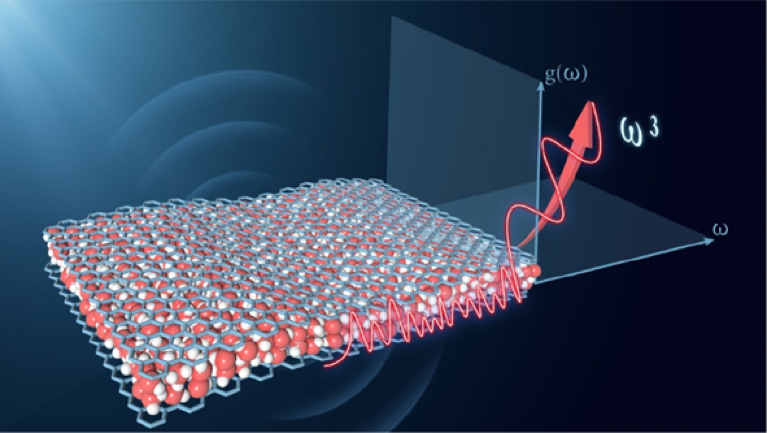

An international collaborative research group led by researchers from Shanghai Jiao Tong University (SJTU) discovered that the low-frequency vibrational density of states (VDOS) of quasi-two-dimensional (quasi-2D) confined solids follows a new physical law faster than that in classical Debye’s theory. The results have been published in Nature Communications.
Atomic vibrations play a vital role in various physical, chemical and biological systems, e.g., facilitating transportation of electrons, diffusion of solvent molecules and binding of the ligand with its target protein. 110 years ago, Peter Debye proposed his famous Debye model, which predicted the ~ ω2 low-frequency scaling of the VDOS for ordered crystals and the subsequent ~T3 low-temperature scaling of specific heat, in agreement with many experimental observations. However, whether the Debye model can be applied to a variety of confined solids remains to be determined.
In this work, inelastic neutron scattering was used to investigate the VDOS of ice nano-confined between graphene oxide membranes at different confinement scales. The team found that the low-frequency scaling of the VDOS of the confined ice varies from the ω2 Debye law to a faster ω3 behavior as the confinement length is reduced. All-atom molecular dynamics (MD) simulations have confirmed the experimental results and have shown that the ω3 scaling appears independently of the crystalline or amorphous nature of the confined ice.
Based on a simple geometric model, the team deduced that the cubic power law arises from the phase space constraints created by confinement. Using the same theoretical framework, the team predicted that the Debye model ω2 scaling would reappear at a higher crossover frequency ωX=2πv/L (where V is the speed of sound in the solid and L is the confinement size). MD simulations further verified this prediction. This work combines experimental, simulation and theoretical research methods to provide a new understanding into the study of vibrational properties of confined solids.
The results have been published in Nature Communications:
The co-first authors of this article are Ph.D. student Yuanxi Yu and Postdoctoral fellow Chenxing Yang from Prof. Liang Hong’s group. Prof. Matteo Baggioli from Wilczek Quantum Center of School of Physics and Astronomy and Prof. Liang Hong fromSchool of Physics and Astronomy, Institute of Natural Sciences and Zhangjiang Institute For Advanced Study jointly supervised this work as corresponding authors. The theoretical model was developed with the help of Dr. Anthony E. Phillips from Queen Mary University of London and Dr. Alessio Zaccone from University of Milan. The neutron scattering experiments were carried out with the help of Dr. Ryoichi Kajimoto, Dr. Mitsutaka Nakamura in J-PARC (Japan) and Dr. Dehong Yu in ANSTO (Australia). The work was supported by National Natural Science Foundation of China, Shanghai Municipal Science and Technology Major Project, Student Innovation Center and Center for High Performance Computing at SJTU.




